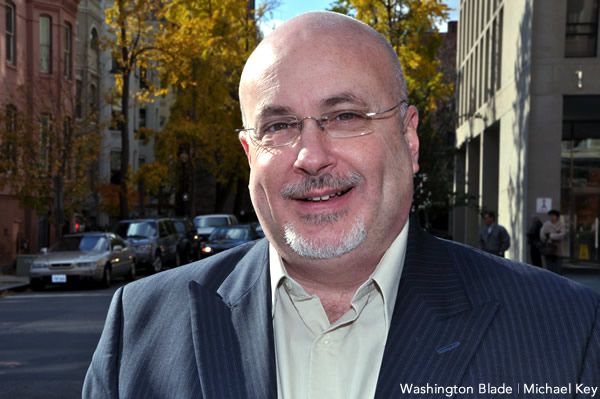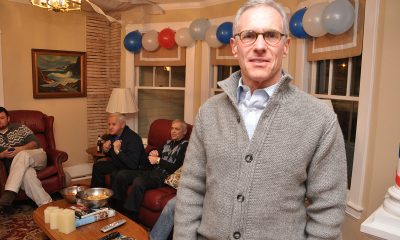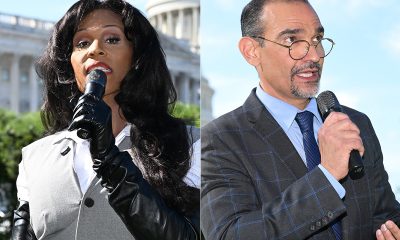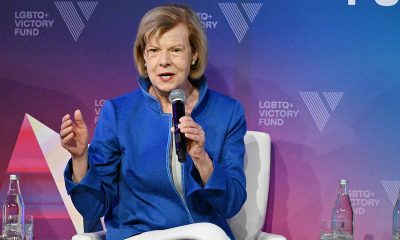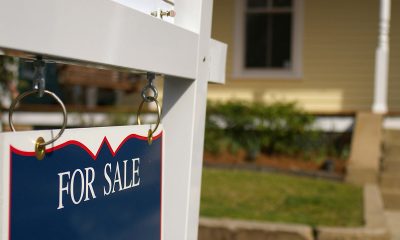National
Gay candidate wins Democratic primary in Wis. congressional bid
Pocan wins nomination to run for Baldwin’s House seat

The gay candidate seeking to replace Tammy Baldwin in the U.S. House claimed the Democratic nomination in the congressional race Tuesday night — all but assuring him a seat in Congress at the start of next year.
The Associated Press reported at around 10:24 pm on Tuesday evening that Mark Pocan, who’s gay and a member of the Wisconsin State Assembly, won the Democratic nomination. His main opponent in the primary was Kelda Helen Roys, a fellow Assembly member.
With 35.6 percent of precincts reporting, Pocan had strong lead over Roys. Pocan had 69.6 percent of the vote, while Roys had 22.7 percent, according to Politico.
The primary coincidentally falls on the same night as Pocan’s birthday; he turns 48 years old on the same day he wins the Democratic primary. Pocan takes the Democratic nomination in the district that Rep. Tammy Baldwin (D-Wis.) is vacating to pursue her run for U.S. Senate.
Wisconsin’s 2nd congressional district, which compromises Madison and nearby areas, is heavily Democratic. The Republican challenger Chad Lee, a businessman, isn’t expected to put up a serious challenge this fall. At this point, the U.S. House seat almost assuredly belongs to Pocan.
Pocan secured endorsements from prominent national LGBT groups, including the Gay & Lesbian Victory Fund and the Human Rights Campaign. Wisconsin’s state LGBT group, Fair Wisconsin, had also endorsed Pocan.
Chuck Wolfe, CEO of the Victory Fund, praised Pocan’s work as a public official and said he’d be a “strong and authentic” voice for the LGBT community in the U.S. House.
“Mark Pocan is an outstanding public servant who will be a strong and authentic voice for LGBT Americans in Congress,” Wolfe said. “It’s fitting that as Congresswoman Tammy Baldwin fights to win a historic victory in the Senate, Mark Pocan will follow in her footsteps as one of the most powerful voices for LGBT equality in America.”
Roys, a former executive director of NARAL Pro-Choice Wisconsin, had the backing of EMILY’s List, which is also supporting Baldwin in her bid for U.S. Senate.
Pocan outraised Roys during the election cycle. According to Federal Election Commission reports, Pocan had $785,000 in net receipts, $512,000 in net expenditures and $273,000 in cash on hand. Only $5,500, or about 1 percent, of his net receipts were from self-financing. On the other hand, Roys had $454,000 in net receipts, $388,000 in net expenditures and $66,000 in cash on hand. Her contributions to her own campaign amounted to $20,000, or about four percent of the total net receipts.
Roys’ negative attack ads against Pocan received significant media attention toward the end of the campaign. Late last month, her campaign began airing an ad saying Pocan “caved in” and voted with Republican Gov. Scott Walker, a Tea Party favorite, to “throw million of dollars in tax giveaways to big corporations.” She took flak from fellow Democrats as a result and lost her endorsement from State Rep. Fred Clark. In response, Pocan said during a news conference the ad was “far fetched.”
Pocan is married to Phil Frank. The couple has been together nearly a decade, and were married almost six years ago in Toronto, although the state doesn’t recognize their marriage due to a constitutional amendment ratified by Wisconsin voters in 2006.
In a Washington Blade interview in November, Pocan said he supports pro-LGBT legislation in Congress, including repeal of the Defense of Marriage Act, which prohibits federal recognition of same-sex marriage, as well as passage of the Employment Non-Discrimination Act and the Uniting American Families Act. As a state lawmaker, Pocan said he played a key role in pushing through domestic partner benefits for state employees and, as part of the state budget, a domestic partner registry enabling same-sex couples to have some rights and responsibilities.
Pocan is one of several openly LGBT candidates who are on the ballot for U.S. House seats this fall. They include incumbents Reps. Jared Polis (D-Colo.) and David Cicilline (D-R.I.) as well as Richard Tisei in Massachusetts, Kyrsten Sinema in Arizona, Mark Takano in California and Sean Patrick Maloney in New York.
The White House
Empty seats, canceled shows plague Kennedy Center ahead of Trump renaming
It would take an act of Congress to officially rename the historic music venue, despite the Trump-appointed board’s decision.

The board of the Kennedy Center in Washington, D.C., voted to rename it the Trump-Kennedy Center, according to the White House Press Office.
White House Press Secretary Karoline Leavitt announced the decision in a post on X Thursday, thanking the president for his work on the cultural center “not only from the standpoint of its reconstruction, but also financially, and its reputation.”
Speaking to reporters later that day at the White House, Trump said he was “surprised” and “honored” by the board’s vote.
“This was brought up by one of the very distinguished board members, and they voted on it, and there’s a lot of board members, and they voted unanimously. So I was very honored,” he said.
Earlier this year, GOP Rep. Mike Simpson of Idaho introduced an amendment that would have renamed the building after first lady Melania Trump, later saying she had not been aware of his efforts prior to the amendment’s public introduction.
Despite the board’s vote (made up of Trump-appointed loyalists), the original laws guiding the creation of the Kennedy Center during the Eisenhower, Kennedy, and Johnson administrations explicitly prohibit renaming the building. Any change to its name would require an act of Congress.
Trump has exerted increasing control over the center in recent months. In February, he abruptly fired members of the Kennedy Center’s board and installed himself as chair, writing in a Truth Social post at the time, “At my direction, we are going to make the Kennedy Center in Washington D.C., GREAT AGAIN.”
In that post, Trump specifically cited his disapproval of the center’s decision to host drag shows.
He later secured more than $250 million from the Republican-controlled Congress for renovations to the building.
Since Trump’s takeover, sales of subscription packages are said to have declined, and several touring productions — including “Hamilton” — have canceled planned runs at the venue. Rows of empty seats have also been visible in the Concert Hall during performances by the National Symphony Orchestra.
“The Kennedy Center Board has no authority to actually rename the Kennedy Center in the absence of legislative action,” House Minority Leader Hakeem Jeffries told reporters.
For decades, the Kennedy Center has hosted performances by LGBTQ artists and companies, including openly queer musicians, choreographers, and playwrights whose work helped push LGBTQ stories into the cultural mainstream. Those artists include the Gay Men’s Chorus of Washington, Harvey Fierstein, and Tennessee Williams.
In more recent years, the center has increasingly served as a space for LGBTQ visibility and acceptance, particularly through Pride-adjacent programming and partnerships.
That legacy was on display at this year’s opening production of Les Misérables, when four drag performers — Tara Hoot, Vagenesis, Mari Con Carne, and King Ricky Rosé — attended in representation of Qommittee, a volunteer network uniting drag artists to support and defend one another amid growing conservative attacks.
“We walked in together so we would have an opportunity to get a response,” said Tara Hoot, who has performed at the Kennedy Center in full drag before. “It was all applause, cheers, and whistles, and remarkably it was half empty. I think that was season ticket holders kind of making their message in a different way.”
The creation of the Kennedy Center is outlined in U.S. Code, which formally designates the institution as the John F. Kennedy Center for the Performing Arts.
As a result, it appears unlikely that Congress will come together to pass legislation allowing the historic venue to be renamed.
The White House
HHS to restrict gender-affirming care for minors
Directive stems from President Donald Trump’s Jan. 28 executive order

The U.S. Department of Health and Human Services announced Thursday that it will pursue regulatory changes that would make gender-affirming healthcare for transgender children more difficult, if not impossible, to access.
The shift in federal healthcare policy stems directly from President Donald Trump’s Jan. 28 executive order, Protecting Children From Chemical and Surgical Mutilation, which formally establishes U.S. opposition to gender-affirming care and pledges to end federal funding for such treatments.
The executive order outlines a broader effort to align HHS with the Trump–Vance administration’s policy goals and executive actions. Those actions include defunding medical institutions that provide gender-affirming care to minors by restricting federal research and education grants, withdrawing the 2022 HHS guidance supporting gender-affirming care, requiring TRICARE and federal employee health plans to exclude coverage for gender-affirming treatments for minors, and directing the Justice Department to prioritize investigations and enforcement related to such care.
HHS has claimed that gender-affirming care can “expose them [children] to irreversible damage, including infertility, impaired sexual function, diminished bone density, altered brain development, and other irreversible physiological effects.” The nation’s health organization published a report in November, saying that evidence on pediatric gender-affirming care is “very uncertain.”
The Centers for Medicare and Medicaid Services is now in the process of proposing new rules that would bar hospitals from performing what the administration describes as sex-rejecting procedures on children under age 18 as a condition of participation in Medicare and Medicaid programs. Nearly all U.S. hospitals participate in Medicare and Medicaid. HHS said that “this action is designed to ensure that the U.S. government will not be in business with organizations that intentionally or unintentionally inflict permanent harm on children.”
Health and Human Services Secretary Robert F. Kennedy Jr. released a statement alongside the announcement.
“Under my leadership, and answering President Trump’s call to action, the federal government will do everything in its power to stop unsafe, irreversible practices that put our children at risk,” Kennedy said. “This administration will protect America’s most vulnerable. Our children deserve better — and we are delivering on that promise.”
Those claims stand in direct opposition to the positions of most major medical and healthcare organizations.
The American Medical Association, the nation’s largest and most influential physician organization, has repeatedly opposed measures that restrict access to trans healthcare.
“The AMA supports public and private health insurance coverage for treatment of gender dysphoria and opposes the denial of health insurance based on sexual orientation or gender identity,” a statement on the AMA’s website reads. “Improving access to gender-affirming care is an important means of improving health outcomes for the transgender population.”
Jennifer Levi, senior director of transgender and queer rights at GLBTQ Legal Advocates and Defenders, warned the proposed changes would cause significant harm.
“Parents of transgender children want what all parents want: to see their kids thrive and get the medical care they need. But this administration is putting the government between patients and their doctors. Parents witness every day how their children benefit from this care — care backed by decades of research and endorsed by major medical associations across the country. These proposed rules are not based on medical science. They are based on politics. And if allowed to take effect will serve only to drive up medical costs, harm vulnerable children, and deny families the care their doctors say they need. These rules elevate politics over children — and that is profoundly unAmerican.”
Human Rights Campaign President Kelley Robinson echoed Levi’s sentiments.
“The Trump administration is relentless in denying health care to this country, and especially the transgender community. Families deserve the freedom to go to the doctor and get the care that they need and to have agency over the health and wellbeing of their children,” Robinson said. “But these proposed actions would put Donald Trump and RFK Jr. in those doctor’s offices, ripping health care decisions from the hands of families and putting it in the grips of the anti-LGBTQ+ fringe. Make no mistake: these rules aim to completely cut off medically necessary care from children no matter where in this country they live. It’s the Trump administration dictating who gets their prescription filled and who has their next appointment canceled altogether.
The announcement comes just days after U.S. Rep. Marjorie Taylor Greene (R-Ga.) advanced legislation in Congress that would make it a felony to provide gender-affirming care to a child.
The White House
As house Democrats release Epstein photos, Garcia continues to demand DOJ transparency
Blade this week sat down with gay House Oversight Committee ranking member

Democrats on the House Oversight Committee have released new photos from Jeffrey Epstein’s email and computer records, including images highlighting the relationship between President Donald Trump and the convicted sex offender.
Epstein, a wealthy financier, was found guilty of procuring a child for prostitution and sex trafficking, serving a 13-month prison sentence in 2008. At the time of his death in prison under mysterious circumstances, he was facing charges of sex trafficking and conspiracy to traffic minors.
Among those pictured in Epstein’s digital files are Trump, former President Bill Clinton, former Trump adviser Steve Bannon, actor and director Woody Allen, economist Larry Summers, lawyer Alan Dershowitz, entrepreneurs Richard Branson and Bill Gates, and Andrew Mountbatten-Windsor.
One photo shows Trump alongside Epstein and a woman at a Victoria’s Secret party in New York in 1997. American media outlets have published the image, while Getty Images identified the woman as model Ingrid Seynhaeve.
Oversight Committee Democrats are reviewing the full set of photos and plan to release additional images to the public in the coming days and weeks, emphasizing their commitment to protecting survivors’ identities.
With just a week left for the Justice Department to publish all files related to Epstein following the passage of the Epstein Files Transparency Act, which requires the Justice Department to release most records connected to Epstein investigations, the Washington Blade sat down with U.S. Rep. Robert Garcia (D-Calif.), the ranking member on the Oversight Committee to discuss the current push the release of more documents.
Garcia highlighted the committee’s commitment to transparency and accountability.

“We’ve said anything that we get we’re going to put out. We don’t care who is in the files … if you’ve harmed women and girls, then we’ve got to hold you accountable.”
He noted ongoing questions surrounding Trump’s relationship with Epstein, given their long history and the apparent break in friendship once Trump assumed public office.
“There’s been a lot of questions about … Donald Trump and Jeffrey Epstein. They were best friends for 10 years … met women there and girls.”
Prior to Trump’s presidency, it was widely reported that the two were friends who visited each other’s properties regularly. Additional reporting shows they socialized frequently throughout the 1990s and early 2000s, attending parties at Trump’s Mar-a-Lago resort in Florida and Epstein’s residences. Flight logs from an associate’s trial indicate Trump flew on Epstein’s private jet multiple times, and Epstein claimed Trump first had sex with his future wife, Melania Knauss, aboard the jet.
“We’ve provided evidence … [that leads to] questions about what the relationship was like between Donald Trump and Jeffrey Epstein.”
Garcia stressed the need for answers regarding the White House’s role in withholding information, questioning the sudden change in attitude toward releasing the files given Trump’s campaign promises.
“Why is the White House trying to cover this up? So if he’s not covering for himself … he’s covering up for his rich friends,” Garcia said. “Why the cover up? Who are you hiding for? I think that’s the question.”
He confirmed that Trump is definitively in the Epstein files, though the extent remains unknown, but will be uncovered soon.
“We know that Trump’s in them. Yeah, he’s been told. We know that Trump’s in them in some way. As far as the extent of it … we don’t know.”
Garcia emphasized accountability for all powerful figures implicated, regardless of financial status, political party, or personal connections.
“All these powerful men that are walking around right now … after abusing, in some cases, 14‑ and 15‑year‑old girls, they have to be held accountable,” he said. “There has to be justice for those survivors and the American public deserves the truth about who was involved in that.”
He added that while he is the ranking member, he will ensure the oversight committee will use all available political tools, including subpoenas — potentially even for the president.
“We want to subpoena anyone that we can … everyone’s kind of on the table.”
He also emphasized accountability for all powerful figures implicated, regardless of financial status, political party, or relationship with the president.
“For me, they’re about justice and doing the right thing,” Garcia said. “This is about women who … were girls and children when they were being abused, trafficked, in some cases, raped. And these women deserve justice.”
“The survivors are strong.”
Deputy White House Press Secretary Abigail Jackson issued a statement regarding the release the photos, echoing previous comments from Republicans on the timing and framing of the photos by the Oversight Committee.
“Once again, House Democrats are selectively releasing cherry-picked photos with random redactions to try and create a false narrative,” Jackson said.
“The Democrat hoax against President Trump has been repeatedly debunked and the Trump administration has done more for Epstein’s victims than Democrats ever have by repeatedly calling for transparency, releasing thousands of pages of documents, and calling for further investigations into Epstein’s Democrat friends,”
In a press release on Friday, Garcia called for immediate DOJ action:
“It is time to end this White House cover-up and bring justice to the survivors of Jeffrey Epstein and his powerful friends. These disturbing photos raise even more questions about Epstein and his relationships with some of the most powerful men in the world. We will not rest until the American people get the truth. The Department of Justice must release all the files, NOW.”





(Photo courtesy of the U.S. House Oversight Committee)

